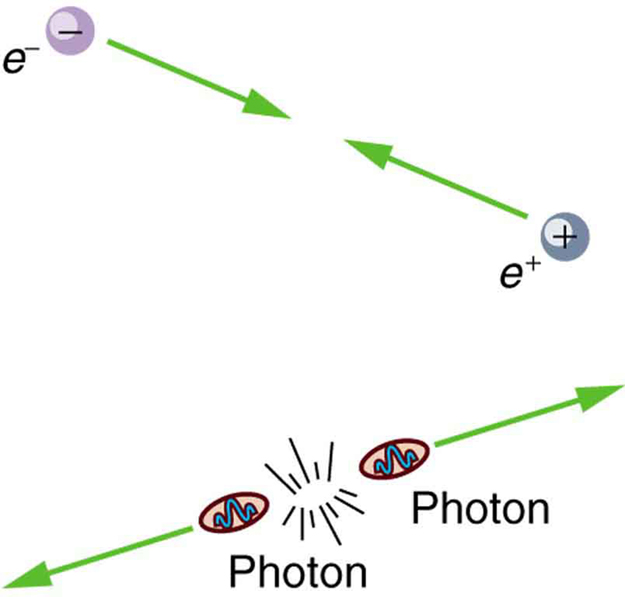| << Chapter < Page | Chapter >> Page > |
Particles can also be revealingly grouped according to what forces they feel between them. All particles (even those that are massless) are affected by gravity, since gravity affects the space and time in which particles exist. All charged particles are affected by the electromagnetic force, as are neutral particles that have an internal distribution of charge (such as the neutron with its magnetic moment). Special names are given to particles that feel the strong and weak nuclear forces. Hadrons are particles that feel the strong nuclear force, whereas leptons are particles that do not. The proton, neutron, and the pions are examples of hadrons. The electron, positron, muons, and neutrinos are examples of leptons, the name meaning low mass. Leptons feel the weak nuclear force. In fact, all particles feel the weak nuclear force. This means that hadrons are distinguished by being able to feel both the strong and weak nuclear forces.
[link] lists the characteristics of some of the most important subatomic particles, including the directly observed carrier particles for the electromagnetic and weak nuclear forces, all leptons, and some hadrons. Several hints related to an underlying substructure emerge from an examination of these particle characteristics. Note that the carrier particles are called gauge bosons . First mentioned in Patterns in Spectra Reveal More Quantization , a boson is a particle with zero or an integer value of intrinsic spin (such as ), whereas a fermion is a particle with a half-integer value of intrinsic spin ( ). Fermions obey the Pauli exclusion principle whereas bosons do not. All the known and conjectured carrier particles are bosons.

| Category | Particle name | Symbol | Antiparticle | Rest mass | Lifetime Lifetimes are traditionally given as (which is , the inverse of the decay constant). (s) | |||||
|---|---|---|---|---|---|---|---|---|---|---|
| Gauge | Photon | Self | 0 | 0 | 0 | 0 | 0 | 0 | Stable | |
| Bosons | 0 | 0 | 0 | 0 | 0 | |||||
| Self | 0 | 0 | 0 | 0 | 0 | |||||
| Leptons | Electron | 0.511 | 0 | 0 | 0 | 0 | Stable | |||
| Neutrino (e) | Neutrino masses may be zero. Experimental upper limits are given in parentheses. | 0 | 0 | 0 | 0 | Stable | ||||
| Muon | 105.7 | 0 | 0 | 0 | 0 | |||||
| Neutrino | 0 | 0 | 0 | 0 | Stable | |||||
| Tau | 1777 | 0 | 0 | 0 | 0 | |||||
| Neutrino | 0 | 0 | 0 | 0 | Stable | |||||
| Hadrons (selected) | ||||||||||
| Mesons | Pion | 139.6 | 0 | 0 | 0 | 0 | 0 | 2.60 × 10 −8 | ||
| Self | 135.0 | 0 | 0 | 0 | 0 | 0 | 8.4 × 10 −17 | |||
| Kaon | 493.7 | 0 | 0 | 0 | 0 | 1.24 × 10 −8 | ||||
| 497.6 | 0 | 0 | 0 | 0 | 0.90 × 10 −10 | |||||
| Eta | Self | 547.9 | 0 | 0 | 0 | 0 | 0 | 2.53 × 10 −19 | ||
| (many other mesons known) | ||||||||||
| Baryons | Proton | 938.3 | ± 1 | 0 | 0 | 0 | 0 | Stable Experimental lower limit is for proposed mode of decay. | ||
| Neutron | 939.6 | ± 1 | 0 | 0 | 0 | 0 | 882 | |||
| Lambda | 1115.7 | ± 1 | 0 | 0 | 0 | 2.63 × 10 −10 | ||||
| Sigma | 1189.4 | ± 1 | 0 | 0 | 0 | 0.80 × 10 −10 | ||||
| 1192.6 | ± 1 | 0 | 0 | 0 | 7.4 × 10 −20 | |||||
| 1197.4 | ± 1 | 0 | 0 | 0 | 1.48 × 10 −10 | |||||
| Xi | 1314.9 | ± 1 | 0 | 0 | 0 | 2.90 × 10 −10 | ||||
| 1321.7 | ± 1 | 0 | 0 | 0 | 1.64 × 10 −10 | |||||
| Omega | 1672.5 | ± 1 | 0 | 0 | 0 | 0.82 × 10 −10 | ||||
| (many other baryons known) |

Notification Switch
Would you like to follow the 'College physics' conversation and receive update notifications?